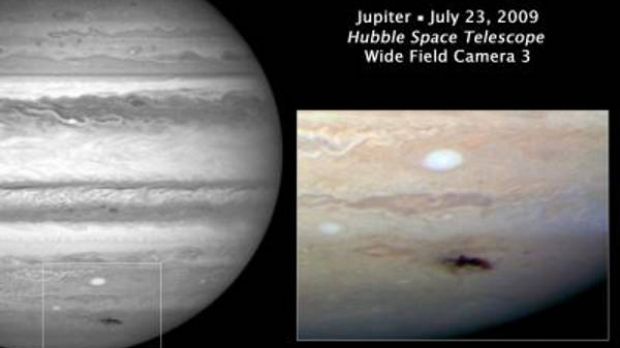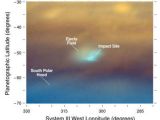A certain point 580 million kilometers away is these days the rage in astronomical observations. A few days ago, an object impacted the planet Jupiter, as we reported. The event was first discovered by an Australian sky watcher, who telephoned NASA and told them about his observations. The impact, which left the planet scarred, occurs 15 years after the 1994 impact, when debris from the Shoemaker Levy 9 comet struck the gas giant and battered it considerably. Now, all telescopes are focused on Jupiter, including the mighty Hubble, which took a series of pictures revealing the extent of the damage.
One of the most revealing photos was taken two days ago by a team of scientists operating Hubble, led by Heidi Hammel, of the Space Science Institute, in Boulder, Colorado. The director of the Space Telescope Science Institute, in Baltimore, Maryland, Matt Mountain, allotted discretionary observation time to the team, so as to get the best possible picture of the “unfolding drama” on our neighbor. The newly installed Wide Field Camera 3 (WFC3) was used for the observations, which were made in visible light wavelengths.
“This is just one example of what Hubble's new, state-of-the-art camera can do, thanks to the hard work of the astronauts and the entire Hubble team. Fortunately, the best is yet to come!” says the associate administrator of NASA's Science Mission Directorate, Ed Weiler. “Hubble's truly exquisite imaging capability has revealed an astonishing wealth of detail in the 2009 impact site. By combining these images with our ground-based data at other wavelengths, our Hubble data will allow a comprehensive understanding of exactly what is happening to the impact debris. My sincerest congratulations and thanks to the team who created Wide Field Camera 3 and to the astronauts who installed it!” Hammel adds.
From the data collected thus far, astronomy teams investigating the incident were able to conclude that the diameter of the rogue object that impacted the gas giant was at least twice the size of several football fields combined. While this is not very accurate, experts underline that more time is needed before a fixed size is established. Additionally, it was also discovered that the explosion that followed that object's descent and disintegration was at least several thousand times more powerful than the 1908 Tunguska River Valley blast, which destroyed about 80 million trees over a 2,150 square kilometer (830 square miles) area.

 14 DAY TRIAL //
14 DAY TRIAL // 
